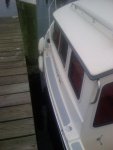matt_unique
New member
- Joined
- Feb 27, 2007
- Messages
- 1,881
- Reaction score
- 0
- C Dory Year
- 2007
- C Dory Model
- 255 Tomcat
- Vessel Name
- Napoleon
What are some of the C-Brat solutions to staying overnight at a non-floating slip?
In the past I would basically adjust the lines every few hours but would not leave the boat unattended for long. It's a pain in the a** of course. I thought I once found a track system that you could fasten to a pylon that would allow you to tie/fender up and the track system would allow for the tide changes.
Thanks for the suggestions.
In the past I would basically adjust the lines every few hours but would not leave the boat unattended for long. It's a pain in the a** of course. I thought I once found a track system that you could fasten to a pylon that would allow you to tie/fender up and the track system would allow for the tide changes.
Thanks for the suggestions.

